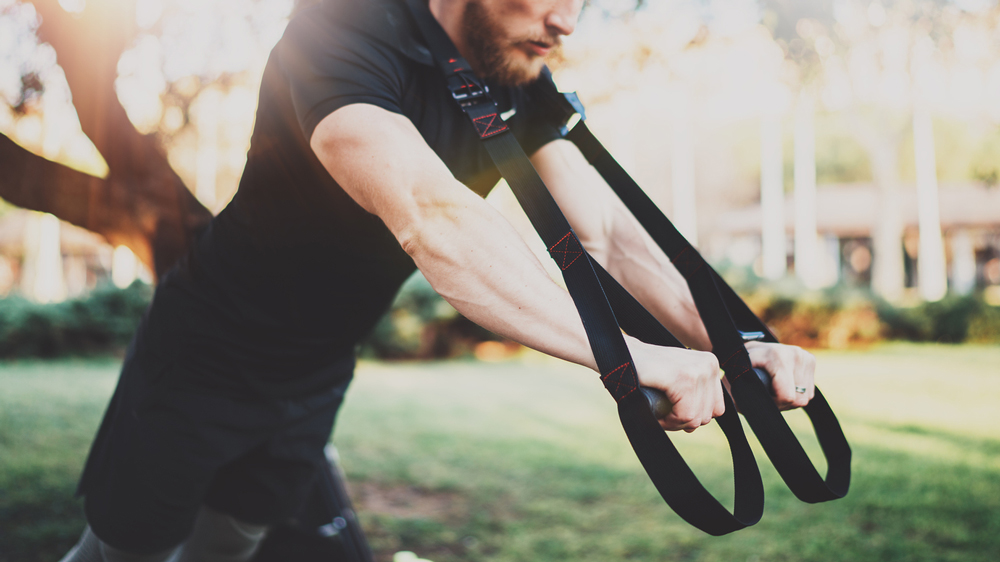The Beginner’s Guide To TRX Training
Let an expert show you the ropes

If you’re on the lookout for a way to freshen up a stale exercise regime – and we all need a change from time to time – then TRX training is well worth a go. Once you get to grips with the suspension system, it can be used to pursue many different goals and, perhaps more importantly, it can be a lot of fun.
A post shared by Niko and Jay (@nikoandjay)
A photo posted by on
Yep, that’s as fun as it looks. (Also, hard.)
For the lowdown on all things TRX, we enlisted personal trainer Niko Algieri from Equilibrium studio in London, who offer group TRX classes.
What is TRX?
“Basically it’s suspension training,” says Algieri. “It’s a dual-strap rope that allows you to suspend different parts of your body off the floor, with the result being that you use your core in every movement that you do.”
The TRX (or Total Resistance exercise, as absolutely no-one calls it) system is a relative newcomer on the fitness scene, having only been created in the late 1990s.
“It was developed by an ex-SEAL called Randy Hetrick,” explains Algieri.
“He was away on tour and wanted to train. Hetrick made it out of a jiu jitsu belt and a little bit of webbing which he hung off the back of a toilet door to use for a couple of pulling exercises.”
Get the Coach Newsletter
Sign up for workout ideas, training advice, reviews of the latest gear and more.
The TRX system has come on a fair bit since then but it’s good to know you can make your own ersatz version of it, if you have some parachute webbing and a belt lying about.
Why should people try TRX training?
“There is really no training system that you can’t do on it,” says Algieri. “You can train for speed, power, strength, flexibility or mobility. You even can do Pilates on it, or yoga.”
“As a one-stop shop, I don't think there’s anything better. You can also use it anywhere. You can hang it off a tree, a goalpost, a door…”
What makes it different to doing normal bodyweight exercises?
You can incorporate the TRX system into almost any bodyweight exercise, suspending some part of your body from the ropes. The benefits differ depending on the exercise. Sometimes the suspension aspect will make the move harder and incorporate more muscles. For others it can make it easier or allow you to attempt a harder version of the exercise.
“A bodyweight squat is better than a TRX squat for you because you support yourself completely,” says Algieri. “But on the flipside, because you’re holding on to these handles, you can lift one of your legs and do a single-leg pistol squat with assistance.”
“You can mix it up as well, or try different angles. There’s a multitude of exercises that are available because you have a strap in your hand or attached to your foot – it’s basically unlimited. There’s nothing you can’t prepare for.”
“The only thing you can’t do is lift. If you wanted to get super-strong then you would have to move on to the free weights.”
What mistakes can beginners make with TRX training?
Assuming your interest in TRX training has been piqued by the above, here are a couple of common mistakes you should try to avoid if you give it a whirl.
“When beginners walk up to the TRX they don’t know how to adjust it, or what the correct lengths for the exercises they are doing are,” says Algieri.
“Say you’re doing a pull exercise, like a row or power pull, you need mid to short strap. Whereas if you’re doing a push motion you need it long strap. Or if you’re doing core exercises, where you suspend your feet to do pikes, swings or knee tucks, it needs to hang to mid-calf length.”
It’s also tempting to let your arms do too much of the work when using the TRX.
“When people grab the handles they instinctively lean back,” says Algieri, “but when you’re doing any leg exercises, like squats or lunges, you need to be upright so your core is engaged. If you lean back you’re relying on your arms and pressing too much into your knees.”
See related

Nick Harris-Fry is a journalist who has been covering health and fitness since 2015. Nick is an avid runner, covering 70-110km a week, which gives him ample opportunity to test a wide range of running shoes and running gear. He is also the chief tester for fitness trackers and running watches, treadmills and exercise bikes, and workout headphones.









